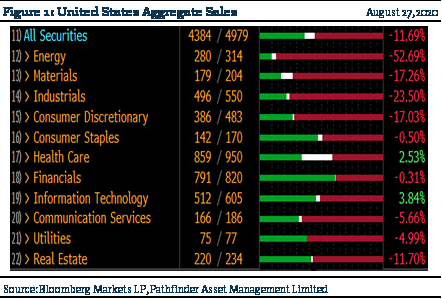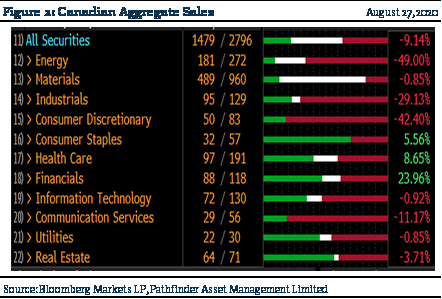Q2 2020 Earnings Season Finished
We last wrote to you at the end of July with respect to the progression of earnings season. Many stock market operators tend to focus on macro analysis and geopolitical events as they relate to the pandemic. At Pathfinder, we spend most of our time discussing and analyzing the businesses that we own. Every 3 months, companies report their financial results and as analysts we go into “earnings season”, which is officially over for the second quarter with the Canadian banks reporting this week. The bank reporting season was interesting this quarter because of the impact of the pandemic. We were impressed with how resilient the Canadian banks were on a relative basis (compared to the US and Europe), which is a testament to the power of the oligopoly that we have in Canada. We noted that while credit losses have increased, the banks remained well capitalized and performed much better than the “the street” expected. Capital markets operations have also provided a substantial cushion to the drop in traditional banking earnings. While it is still early days, and we expect more difficulty for the Canadian economy, it is nice to see some constructive results.
- In the United States, 88% of companies have reported and on a broad basis, it looks like total revenue is tracking down an historic -11.7% over the quarter. Sales have deteriorated from -10.7% at the beginning of the quarter. As you can see in Figure 1, only technology and heath care have posted positive sales growth over the quarter and the cyclical components of the economy (mining, energy, industrials, and discretionary consumption) have really suffered. While it is alarming, it does make sense given the situation.

- In Canada, 52% of companies reported and compared to the beginning of the season, there has been some improvement; however, sales are still down -9.1%. While energy stocks remain depressed, materials companies were better than their US counter parts, most likely due to the fact that we have more mining than industrial materials companies in Canada (94% in Canada vs. 39% in the US). The Canadian results were also driven higher by better financials results, which we alluded to above.

“This means that” corporate results have come in as we had previously expected and from an economic perspective, the situation continues to remain difficult. Next quarter will be even more interesting given the start and stop of reopening from various parts of North American and the rest of the world.
National Instrument 31-103 requires registered firms to disclose information that a reasonable investor would expect to know, including any material conflicts with the firm or its representatives. Doug Johnson and/or Pathfinder Asset Management Limited are an insider of companies periodically mentioned in this report. Please visit www.paml.ca for full disclosures.
*All returns are time weighted and net of investment management fees. Returns from the Pathfinder Partners’ Fund and Pathfinder Real Fund are presented based on the masters series of each fund. The Pathfinder North American Equity Portfolio and The Pathfinder North American Income Portfolio are live accounts. These are actual accounts owned by the Pathfinder Chairman (Equity) and client (High Income) which contain no legacy positions, cash flows or other Pathfinder investment mandates or products. Monthly inception dates for each fund and portfolio are as follows: Pathfinder North American Equity Portfolio (January 2011), Pathfinder North American High-Income Portfolio (October 2012) Pathfinder Partners’ Fund (April 2011), Pathfinder Real Fund (April, 2013), and Pathfinder International Fund (November 2014).
Pathfinder Asset Management Limited (PAML) and its affiliates may collectively beneficially own in excess of 10% of one or more classes of the issued and outstanding equity securities mentioned in this newsletter. This publication is intended only to convey information. It is not to be construed as an investment guide or as an offer or solicitation of an offer to buy or sell any of the securities mentioned in it. The author has taken all usual and reasonable precautions to determine that the information contained in this publication has been obtained from sources believed to be reliable and that the procedures used to summarize and analyze such information are based on approved practices and principles in the investment industry. However, the market forces underlying investment value are subject to sudden and dramatic changes and data availability varies from one moment to the next. Consequently, neither the author nor PAML can make any warranty as to the accuracy or completeness of information, analysis or views contained in this publication or their usefulness or suitability in any particular circumstance. You should not undertake any investment or portfolio assessment or other transaction on the basis of this publication, but should first consult your portfolio manager, who can assess all relevant particulars of any proposed investment or transaction. PAML and the author accept no liability of any kind whatsoever or any damages or losses incurred by you as a result of reliance upon or use of this publication.